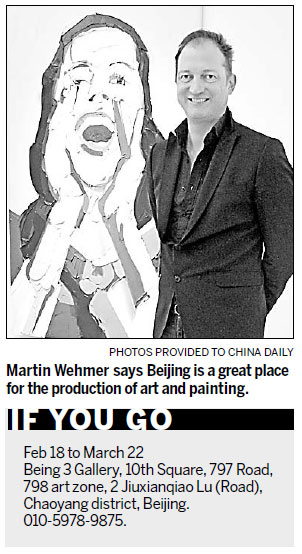Window into a new kind of reality
Updated: 2014-03-16 08:09
By Chen Nan(China Daily)
|
|||||||
For painter and art educator Martin Wehmer, his turning point came in 2008, the year when he came to Beijing as a resident artist with an art grant from Switzerland. Since then, he has been painting in China, which, as he puts it, "gives me a special situation, between two worlds, more and more independent from where I come from".
As an artist who has been focusing on painting and different culture and art history, he considers art in his home country, Germany, "a little bit slow now and something is missing".
"Beijing is a great place for the production of art and painting. It gives me the freedom to do things, to take more risks. Somehow we all are working for the future of art," says the 48-year-old Wehmer from Hettingen, Germany.
In his ongoing exhibition held at Beijing's Being 3 Gallery in the 798 art zone, he is displaying 18 paintings, two of which he created in 2011, while the remainder were painted in 2013 and 2014.

He draws a parallel between painting and gardening, in the sense that he needs to tend to his work almost every day in his studio as gardeners would their plants in a garden. When he arrived in Beijing, contemporary art was booming, he says, but has now calmed down and galleries are focusing much more on long-term quality.
The artist gives no name for his style but says "it is in the meaning of a post-abstraction painting in the field between abstraction and figurism, in the triangle to a concept". Put simply, his paintings combine abstraction and figurative imagery into bold lines and color.
Viewers could sense it through his works, such as Sun Wukong, also known as the Monkey King, the main character in the 16th-century Chinese novel Journey to the West by Wu Cheng'en.
"I found the Western abstraction in the face or mask of Sun Wukong. It has the function of a bridge between the West and East for me," he says. "It's a period of assimilation and you touch things you don't know. It can be naive, it can be wise and this neutral point is the best situation for painting.
"Having spent several years in China and using a strongly expressive brush, he sees the calligraphic stroke as an influence on the Abstract Expressionism of the West itself," says curator Ronald Kiwitt, director of Beijing and Shanghai-based Other Gallery.
According to Catherine Cheng, Wehmer's manager and the exhibition's co-curator, Wehmer's recent works are composed of recognizable images carrying conceptual significance by means of his abstract expressionist technique.
"He provides us with a new experience and perspective, which enables us to see more clearly through the diversity of civilization and opens the window onto a new kind of reality," Cheng says.
In particular, The Green Woman with a Paper in Hand is a breakthrough in his painting, says Cheng, as it juxtaposes the image into the imagination, implying a concept behind the image. As a result, his work initiates an international form, which pushes beyond the limits of Abstract Expressionism.
Cheng met Martin for the first time in 2008 while he was the co-curator of the 798 Art Biennale. She did not know that he was a painter at the time, as he was a man of few words. In 2010, he was reintroduced to her and it was only then that she got to know his work. "I prefer to call him a 'research painter' since every work contains extensive research and contemplation. With an average of 30 works each year, he does not produce more work than is necessary," she says.
Wehmer became a practicing painter after receiving his formal art education in Germany. He has received several art awards from the Academy and Art Fund in Europe and has his works exhibited in art fairs and museums, including the Zurich Art Fair, and the Museum in Basel.
He's proficient in art history. Wehmer's knowledge extends to issues of international contemporary art. He is a dedicated painter as well as an art educator. In his role as art lecturer at CDK Hangzhou, a joint program with UDK Berlin, he facilitates art exchange programs between China and Germany.
"The daily life of students is becoming more similar between China and the West," he says. "China moves so fast. It is good for art."
chennan@chinadaily.com.cn
(China Daily 03/16/2014 page5)